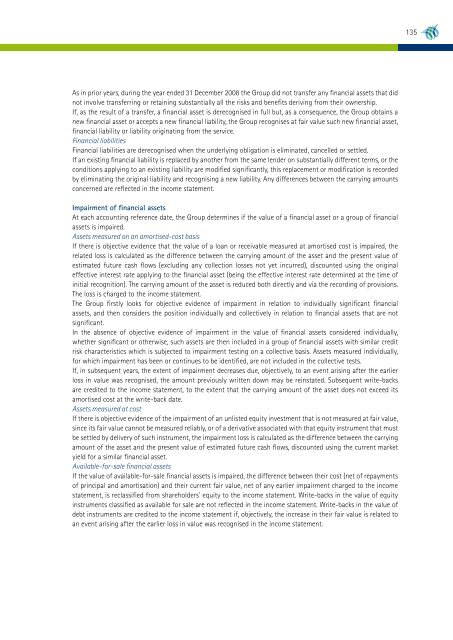Save PDF - Manutencoop
Save PDF - Manutencoop
Save PDF - Manutencoop
You also want an ePaper? Increase the reach of your titles
YUMPU automatically turns print PDFs into web optimized ePapers that Google loves.
135<br />
As in prior years, during the year ended 31 December 2008 the Group did not transfer any financial assets that did<br />
not involve transferring or retaining substantially all the risks and benefits deriving from their ownership.<br />
If, as the result of a transfer, a financial asset is derecognised in full but, as a consequence, the Group obtains a<br />
new financial asset or accepts a new financial liability, the Group recognises at fair value such new financial asset,<br />
financial liability or liability originating from the service.<br />
Financial liabilities<br />
Financial liabilities are derecognised when the underlying obligation is eliminated, cancelled or settled.<br />
If an existing financial liability is replaced by another from the same lender on substantially different terms, or the<br />
conditions applying to an existing liability are modified significantly, this replacement or modification is recorded<br />
by eliminating the original liability and recognising a new liability. Any differences between the carrying amounts<br />
concerned are reflected in the income statement.<br />
Impairment of financial assets<br />
At each accounting reference date, the Group determines if the value of a financial asset or a group of financial<br />
assets is impaired.<br />
Assets measured on an amortised-cost basis<br />
If there is objective evidence that the value of a loan or receivable measured at amortised cost is impaired, the<br />
related loss is calculated as the difference between the carrying amount of the asset and the present value of<br />
estimated future cash flows (excluding any collection losses not yet incurred), discounted using the original<br />
effective interest rate applying to the financial asset (being the effective interest rate determined at the time of<br />
initial recognition). The carrying amount of the asset is reduced both directly and via the recording of provisions.<br />
The loss is charged to the income statement.<br />
The Group firstly looks for objective evidence of impairment in relation to individually significant financial<br />
assets, and then considers the position individually and collectively in relation to financial assets that are not<br />
significant.<br />
In the absence of objective evidence of impairment in the value of financial assets considered individually,<br />
whether significant or otherwise, such assets are then included in a group of financial assets with similar credit<br />
risk characteristics which is subjected to impairment testing on a collective basis. Assets measured individually,<br />
for which impairment has been or continues to be identified, are not included in the collective tests.<br />
If, in subsequent years, the extent of impairment decreases due, objectively, to an event arising after the earlier<br />
loss in value was recognised, the amount previously written down may be reinstated. Subsequent write-backs<br />
are credited to the income statement, to the extent that the carrying amount of the asset does not exceed its<br />
amortised cost at the write-back date.<br />
Assets measured at cost<br />
If there is objective evidence of the impairment of an unlisted equity investment that is not measured at fair value,<br />
since its fair value cannot be measured reliably, or of a derivative associated with that equity instrument that must<br />
be settled by delivery of such instrument, the impairment loss is calculated as the difference between the carrying<br />
amount of the asset and the present value of estimated future cash flows, discounted using the current market<br />
yield for a similar financial asset.<br />
Available-for-sale financial assets<br />
If the value of available-for-sale financial assets is impaired, the difference between their cost (net of repayments<br />
of principal and amortisation) and their current fair value, net of any earlier impairment charged to the income<br />
statement, is reclassified from shareholders' equity to the income statement. Write-backs in the value of equity<br />
instruments classified as available for sale are not reflected in the income statement. Write-backs in the value of<br />
debt instruments are credited to the income statement if, objectively, the increase in their fair value is related to<br />
an event arising after the earlier loss in value was recognised in the income statement.








